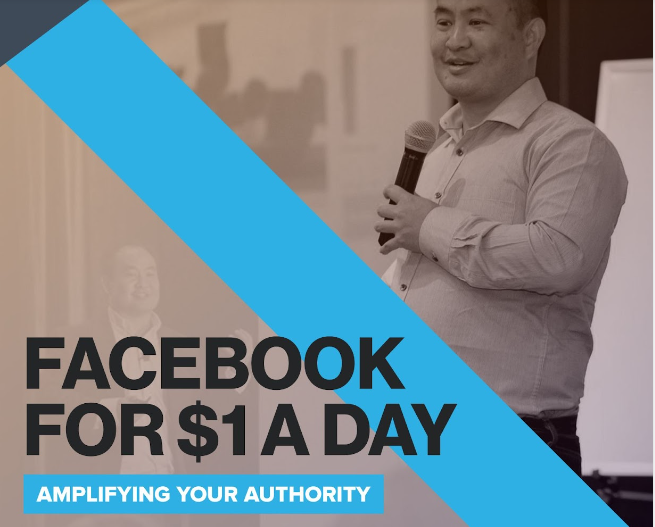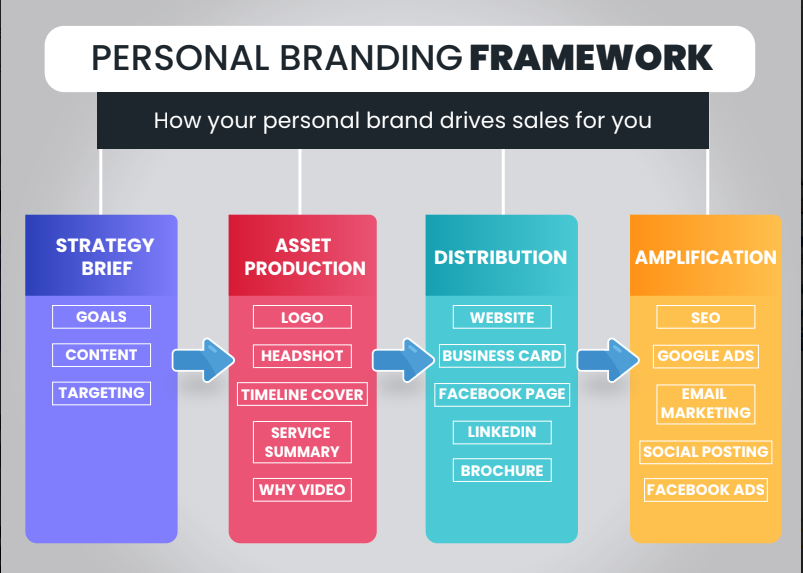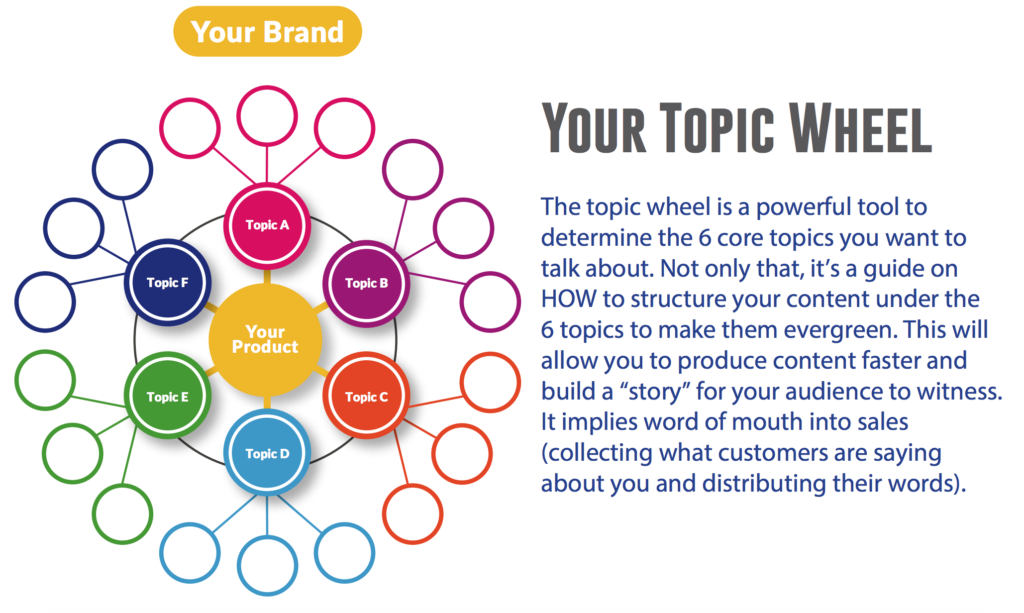So most people, when they go into digital, look at one channel, focus on PPC or find social media interesting or they start with the tool. They start building websites and their digital journey usually is haphazard. Because it’s just whatever their friends are working on, or they get a client and whatever that client needs, that’s the skill that they acquire, but it’s not put into an overall system.
So the success of most people that do marketing, whether it’s for themselves or for business owners tends to be kind of random because you might as well just put a blindfold on and throw a dart. Sometimes you are lucky and sometimes you don’t and what people miss is realizing that Marketing should not be left to random activities and there are repeatable frameworks for execution.
And when there are things like TikTok that come along or new AI-driven tools, you’ll see anything that comes out as something that’s familiar because you’ll have an overall framework to put everything into.
Below are the different pieces and how they fit into the social amplification engine.

1. Strategy Assessment
Strategy is very important. People say strategy, they don’t know what strategy is, but it’s school’s content and target. If you know GCT (Goals, Content and Target) then we have the necessary ingredients that we can do anything that’s channel-specific. We can run ads, do organic stuff, set up email, whatever it might be because we know who’s buying, why they’re buying, what the need is and the product the market needs.
2. Goal
We can then start to make a one-minute video, now 15-second videos because of TikTok, 15-second selfie stories with lots of examples. So it makes sense that before you start one-minute videos, you have to know what you’re making the videos about. You have to know what the pain points are. You have to know what the value proposition is, which goes back to the strategy.
Finding Goal Setting difficult? We understand that it might be difficult to set goals if you don’t understand what is considered ‘excellent.’ Here is a Goal-Standard of Excellence course that would help.
3. Content
If you’ve got the strategy and you’re starting to produce content around strategy. In one-minute videos, you can then repurpose it into a website, repurpose it into any other social channel, and repurpose it in the email subject lines.
So making one-minute videos is the perfect way to capture content. Some people wanna go live and if that’s a great way to give you the impetus to the discipline to make sure you’re making the one-minute videos, great! But we wanna repurpose videos into things that stay longer on social media.
You’ll hear social media consultants saying you have to make content that’s just for TikTok, cuz it needs to look like TikTok and it should be native to TikTok or it needs to be YouTube and you gotta call it out, “Hey YouTube”. I don’t think that we can separate the two and I’ve spent a lot of time with people who are very successful on the internet wherein they decoupled the two.
They’re gonna repurpose and understand there are different formats that the channels have, but we don’t have to create content for each particular channel that we have here.
You may have heard from people who talk about content marketing how you need ‘great content,’ but how, exactly does one create ‘great content. Here is a course that will teach you just how to do Content the right way.
4. Targeting
So this is all the stuff that we’ve talked about with the tools. SEO related with WordPress to different WordPress plugins like RankMath, Link Whisper, Yoast, and other ways where we can have things be seen by Google. And we’ve done a lot of training on SEO. We have our SEO 101 course.
Want to start targeting on Facebook? Here is a guide on How To Use Facebook Audience Insights To Understand Targeting
5. Amplification
Amplification is mostly advertising, but we didn’t call it advertising because the idea of amplification is how do we get more out of something that’s already good. Like if we respond to people, that’s amplification. Happy customers. If we interview them, we send them gifts. That’s amplification. If we start a podcast. All kinds of things that we can do to try to get more out of something, that’s good. That’s not advertising.
Advertising’s the easiest way because that’s what the networks are designed to do. That’s how the networks–Facebook and Google make their money.
Amplification can be SEO’s amplification, even though SEO is technically not paid, but when you’re repurposing content, when you’re learning what’s working– when you’re saying thank you, when you speak at a conference, when you build a brand, when you put a book out, when you have a great article and then you decide to write a book on that, that’s amplification. It’s taking something good and getting more out of that.
Potentially the most powerful concept in digital marketing is Amplification because it’s merely saying what is working well for you? What is the thing that you are best known for? And how do we do more of that? Well, you can only work so many hours, so there’s a limit to that.
So some people call that prioritization of focus, but I call it amplification because we can hire VAs to do more of it. We can run ads against it. Like how do we get more?
And cuz he’s amplifying upon the thing that he’s already known for. So you can see when we have the goal, content, and targeting. What is it that we want people to do?
You can pretty much say, my goal is conversions or leads. I want phone calls, or I want people filling out a form, or I want people to buy the thing on Amazon. If you’re clear on what the objective is, the goal, and you have the content– one-minute videos and you have the targeting, your custom audiences and lookalikes, then it’s really channel independent. You don’t have to worry about the channels.
6. Optimization
Most people still don’t have a company page and what they have is a profile. We can’t run ads on a profile page and it needs to be a Company Facebook page. Then if they make why, how, and what videos they can turn into articles, put them on the website here.
Then they have a three-by-three. They take the best three of each of these. Now they have a three-by-three and run dollar a day against it.
As we do more of the testing of these different videos or landing pages or offers, then we optimize. But in order to optimize, we have to track. Who’s competing with what? So maybe we have a couple of different customer segments.
Maybe we have a key product. Maybe we have a certain video that’s a certain part of the funnel. Then we need to keep track of it in the content library so we can make more of what’s working.
Then we can take the content and start to go into things like how does the algorithm work or how do we film content better with the video camera? How do we interview people as part of a podcast and repurpose it?
So when you have goals, For example, I need to acquire customers at less than $35, or I need to sell this product, you know, whatever, get the LTV over $300 or get patients that have a $5,000-lifetime value.
So what I have is metrics that I need to hit, not just a cost per, but a volume metric, right? Not just $35 a lead, but I need to make $20,000 a month or whatever the number is– Qualitative, Quantitative. But then once I have these goal numbers, that doesn’t mean anything unless I have content associated with that. So every piece of content you have should anchor back to your goals. And if not, then maybe it’s just something fun with your dog. And there’s no goal for that. You’re just putting it out there because it’s a branding thing. It’s a personality.
So naturally short-form video leads itself into things. Repurpose or cross-post into the web and then into a dashboard cause once you have multiple channels, you need to measure because we wanted to allocate a budget for a client on how much we will spend on Facebook, how much was Google? Should we try LinkedIn? Should we try some new things that are occurring? And you will never really know unless you have some kind of dashboard, some sort of analytics, some way of being able to do metrics analysis and action, to be able to optimize in tune for what makes the most sense.
But if you don’t have a machine that’s already working, then why would you want any kind of analytics or dashboard? There’s nothing to optimize.
You have to have things that are working organically and put analytics or processes around them. It could be weekly, or monthly. It could be like what we teach in the dollar day course where you’re just boosting posts for seven days for $1, for $7. Then that forms the framework of the dollar-a-day ads.

Dollar a Day Ads is where we take something that we think is resonating– works organically. Maybe it works on LinkedIn then let’s adapt it on YouTube as a six-second bumper or a video that worked well on Instagram, or maybe a piece of a zoom call. So we have top and bottom, and there’s a format that will work well in TikTok. And we can have a dollar a day on Facebook and Dollar a day on Twitter. We can do Dollar a Day for media targeting. And then we move into things like Google ads.
A lot of people would say, let’s just start with Google apps. That’s the easiest way to ROI with the highest intent of knowing what the keywords are of the competitors and working on those same keywords to rank.
So Google ads can’t really work unless these other pieces are already in place because the cost of traffic has gone way, way up the tracking is more difficult.
Like there are all these different things that help us measure better and optimize better. But with a lot of measurement, I think 30% of conversions can’t be measured anymore. That’s just gone. We’re not gonna get that back. The cost of traffic going way up that I think it’s even more important to have these other components:
- Strategy
- One minute videos
- Website
- Analytics
- Lightweight boosting
- Google Ads
But not that everyone has to go through the exact same path.
If you are in B2B, then you can focus more on LinkedIn because of the nature of a Complex sale that goes through a lead that has multiple decision-makers that are involved versus just someone who’s buying a product or service– one click on Amazon.
And when you integrate, how do you bring these different pieces together? So we’re running video and images and keywords inside Google. So this is what I think should happen from a general strategy startup standpoint.
Here is an example of another framework. The Personal Branding Framework.

So these same four phases for personal brand are the same phases for a business and the same phases for any kind of marketing. It follows the same kind of process where you have to know what it is that you’re talking about–strategy, then creates lightweight videos around it and be able to repurpose it.
So then when we break down the production of these, when you have a strategy and there’s the production of the one-minute videos, how do we get more intelligent about what kind of content we do?
Do you build it around a topic wheel?

When you have goals, what does that mean? Is it a financial goal? Is it a mission-driven goal? Like our mission-driven goal is to create a million jobs.
And then who’s it for, so when we talk about the XYZ model like I help X achieve Y through Z. That’s goals, content, and targeting, except that I help X, which is the targeting achieve Y which is the goal via Z, which is your framework. Then you produce these different combinations of assets.
It can be the speaker reel. It can be 15-second videos. It can be articles. It can be courses. It can be timeline covers. It doesn’t have to be just, colors and fonts and logos and things like that. And then push it out to distribution so it shows in channels:
- Quora
- Snapchat
- Website
- YouTube
- Google my business.
There’ll be so many channels and then of course you want to put ads against it.
So the topic wheel by definition organizes your goals and content together. This sounds kind of theoretical, but it really is important to have a content strategy. If you don’t have a content strategy, you’re just going to go for quantity– you have a VA make 10 pieces of content for you every week, but then how do you tell them what to do?
And how do you know if it’s any good to go back to the goals? The only way to make an impact on any one of these goals is through content and targeting. That’s another way to look at it.
So goals, content, and targeting is the heart of every engine.
Want to grow your online presence and turn yourself into a thought leader? Here is a Personal Branding Course that you can check out.
So this whole thing about the social amplification engine conceptually means businesses grow because of word of mouth, of people that love them. Your customers do the work for you.
So you are amplifying the social proof, the Yelp reviews, and the feedback that people provide. You’re making it visible through this engine. The engine is a process, the process to collect content, the process to edit it, the process to distribute it, all the things that we showed in the four-step content factory.
So the idea of a social amplification engine is I’ve got something good and I wanna make it better. I wanna get more out of it. How do I amplify the good things that my customers are already saying about me? And that is where I need the engine. I need the process, the engine, the people, and the platform.
Ready to take your journey to the next level? Look at what you know, and what your experience is right now, and start to fill in the gaps from the framework!
